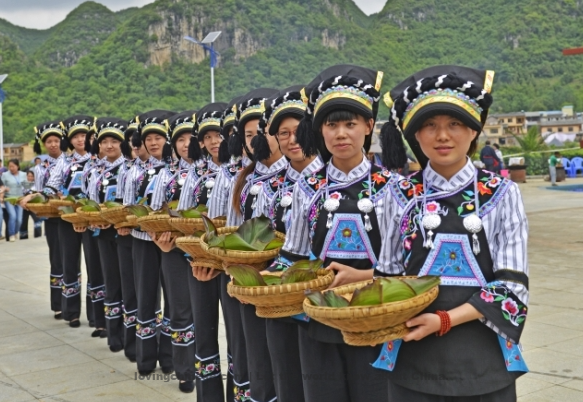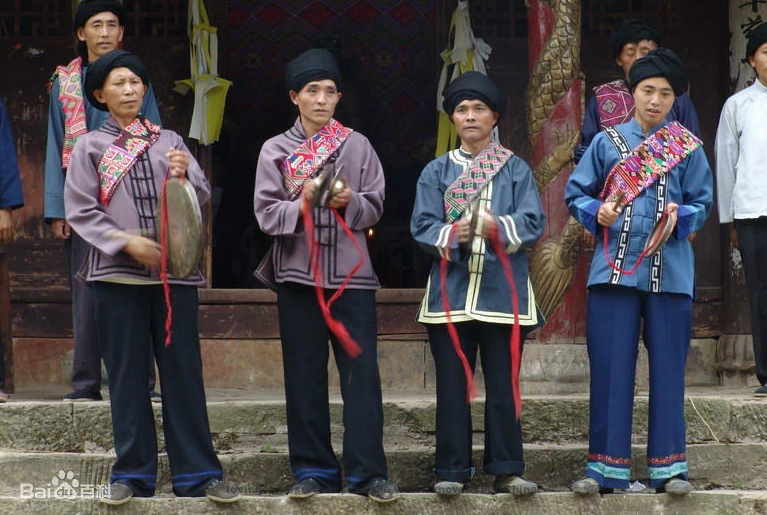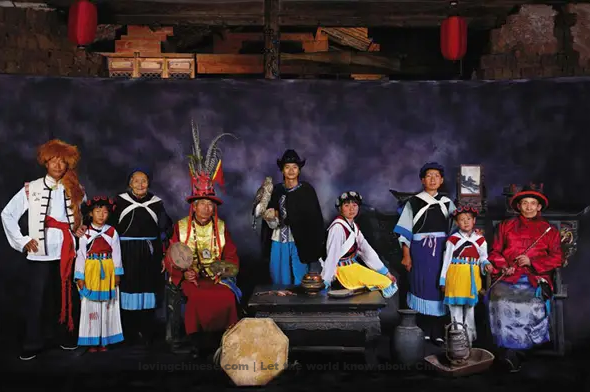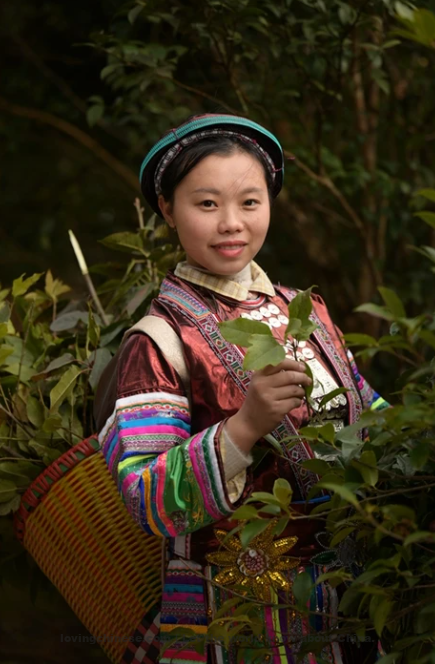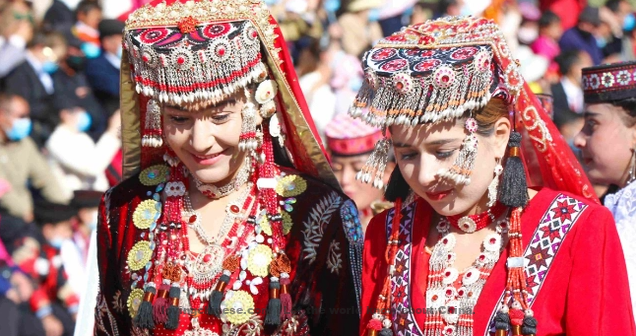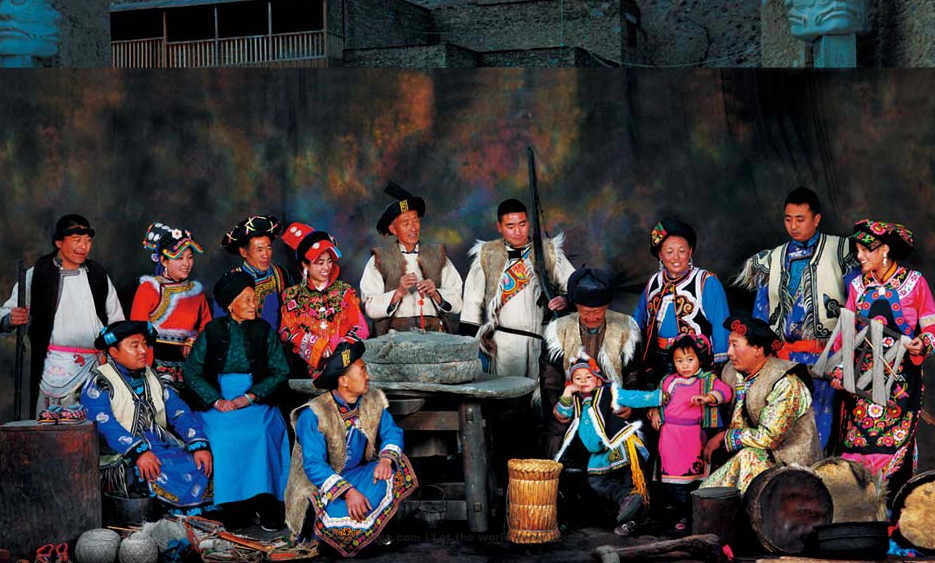-
Chinese Nation – Dong nationality
Dong nationality is a minority nationality in China, whose language is Dong language. It belongs to the Dongshui branch of the Zhuang Dong language group in the Sino Tibetan language family and believes in many gods. The ancestors of the Dong nationality are called "the head of Guizhou" in the literature before the pre-Qin period. It is generally believed that the Dong nationality developed from a branch of ancient Baiyue. The Dong people are mainly engaged in agriculture, and the agriculture is mainly rice planting. Rice planting has a long history, and they are also engaged in forestry. The production of agriculture and forestry has reached a very high level. There are many basins called "Bazi" in the Dong area. Dong people are mainly distributed in Qiandongnan Miao and Dong Autonomous Prefecture and Tongren area of Guizhou Province, Xinhua Dong Autonomous County, Huitong County, Tongdao Dong Autonomous County, Zhejiang Dong Autonomous County, and Jingzhou Miao and Dong Autonomous County of Hunan Province, Sanjiang Dong Autonomous County, Longsheng Miao Autonomous County and Rongshui Miao Autonomous County of Guangxi Zhuang Autonomous Region, Enshi Tujia Miao Autonomous Prefecture of Hubei Province, etc. Diet Dong people eat rice as their staple food, and they…- 0
- 0
- 17
-
Chinese Nation – Bouyei
Bouyei, a large minority in Southwest China, is spoken in the Bouyei language. The Sino Tibetan language belongs to the Zhuang Dai branch of the Zhuang Dong ethnic group. It is closely related to the Zhuang language and is commonly used in Chinese. The Bouyei people evolved from the Liao people in ancient times, mainly in agriculture. The ancestors of the Buyi people began to grow rice very early, which is known as the "rice nation". Bouyei people are mainly distributed in Guizhou, Yunnan, Sichuan, and other provinces, among which Guizhou Province has the largest Buyi population, accounting for 97% of the national Buyi population. They mainly live in Qiannan and Qianxinan Buyi and Miao Autonomous Prefectures, as well as Anshun City, Guiyang city, and Liupanshui City. The rest of the cities, prefectures, and districts are scattered, and a small part of them live in Vietnam. Language Bouyei language belongs to the Zhuang Dong language family of the Sino Tibetan language family and has a close kinship with the Zhuang language. The northern dialect of the Zhuang language is basically the same as the Buyi language in Wangmo, Cheng, Dushan, Pingtang, Anlong, and Xingyi counties of Guizhou. Due to the…- 0
- 0
- 12
-
Chinese Nation – Bourau
The Bourau nationality, formerly known as the Zhuang nationality, is a minority with the largest population in China. The national language is Zhuang, belonging to the Zhuang Dai branch of the Zhuang Dong language family of the Sino Tibetan language family. The Zhuang nationality originated from "Xi'ou" and "Luo Yue" in the Lingnan area recorded in Han historical records in pre-Qin, Qin, and Han Dynasties. It is distributed in 31 provinces, autonomous regions, and municipalities directly under the central government in China, mainly in the south, starting from Lianshan Zhuang and Yao Autonomous County in Guangdong Province in the East, Wenshan Zhuang and Miao Autonomous Prefecture in Yunnan Province in the west, and Congjiang County in Qiandongnan Miao and Dong Autonomous Prefecture in Guizhou Province in the north, South to Beibu Gulf. Guangxi Zhuang Autonomous Region is the main distribution area of Zhuang nationality. Diet The Zhuang people in most areas are used to eating three meals a day, while the Zhuang people in a few areas also eat four meals, that is, a small meal is added between lunch and dinner. Breakfast and Chinese food are relatively simple, generally eat porridge, dinner for dinner, eat dry rice, dishes are…- 0
- 0
- 14
-
Chinese Nation – Tibetan
Tibetan is one of 56 nationalities in China and the indigenous people of the Qinghai Tibet Plateau. In China, it is mainly distributed in the Tibet Autonomous Region, Qinghai Province, Western Sichuan Province, Diqing of Yunnan Province, Gannan of Gansu Province, and other regions. Besides, it is also distributed in India, Bhutan, the United States, Canada, Europe, Australia, and other regions. Lhasa is the holy land of the Tibetan people. At present, there are about 7.5 million Tibetans in the world, about 7 million in China (2016), and the conservative estimate of the Tibetan population is more than 10 million. Tibetan history is an integral part of Chinese history and one of the oldest ethnic groups in China and South Asia. After the establishment of the Tubo government in the early 7th century, the contact between Tubo and Tang Dynasty became more and more frequent. From the 10th century to the 16th century, the ancient Tibetan culture flourished. In 1951, Tibet was peacefully liberated. Tibetans have their own language and writing. Tibetan belongs to the Tibetan branch of Tibeto Burmese language family of Sino Tibetan language family, which is divided into three dialects: Wei Tibetan, Kang, and Ando. Tibetans generally… -
Chinese Nation – Mongols
Mongols, a traditionally nomadic people mainly distributed in East Asia, is one of the ethnic minorities in China, and also the main ethnic group in Mongolia. In addition, it is also considered to be a branch of Mongols in Russia. The Mongols originated from the East Bank of Wangjian River in ancient times. At the beginning of the 13th century, the Mongolians headed by Genghis Khan unified all the Mongolians and gradually formed a new ethnic community. Mongolian people live in grassland for a long time and live by animal husbandry. Living a nomadic life of "living by water and grass", although this way of life has been weakened in modern society, it is still regarded as the symbol of Mongolian. Mongolian people are more developed in science and culture, and music and dance also occupy a relatively prominent position in art. Development history There are about 10 million Mongolians in the world. The language is Mongolian. Half of them live in the territory of the people's Republic of China. In 1271, the name of the Mongol Khanate was changed to Yuan state, or "Tuolei Khanate", which is the official beginning of the Yuan Empire. Kublai Khan became the emperor,… -
Chinese Nation – Yi nationality
The Yi nationality is the sixth-largest ethnic minority in China. Its national language is Yi language. It belongs to the Yi branch of Tibeto Burmese language family of Sino Tibetan language family. There are six dialects in North, East, South, Southeast, West, and central China, including five sub-dialects and 25 local dialects. The Yi people are mainly distributed in Yunnan, Sichuan, Guizhou, and Guangxi provinces (regions) between the plateau and coastal hills, mainly gathered in Chuxiong, Honghe, Liangshan, Bijie, Liupanshui, and Anshun, etc. Liangshan Yi Autonomous Prefecture is the largest Yi nationality inhabited area in China. Before the founding of new China, due to different regions and dialects, there were many branches of the Yi nationality. There were many different other names and self names, including "Yi", "Heidi", "Baiyi", "Hongyi", "many", "Huayao", "Micha" and so on. Among the main self names, the Yi people in Zhaotong, Wuding, Luquan, Maitreya and Shiping of Yunnan Province, and the Yi people in Daliang and Xiaoliangshan of Sichuan Province call themselves "Nuosu", "Nasu" and "niece", which account for about half of the total population. The Yi people in Ailao Mountain, Wuliang Mountain, Kaiyuan, Wenshan, and Magan in Yunnan call themselves "Misha (PO)", "last (PO)",…- 0
- 0
- 23
-
Chinese Nation – Hmong
The Hmong is an ancient ethnic group scattered all over the world, mainly in the provinces of Guizhou, Hunan, Hubei, Sichuan, Yunnan, Guangxi, and Qiong in China, as well as Laos, Vietnam, Thailand and other countries and regions in Southeast Asia. According to historical records and Miao people's word-of-mouth information, the ancestors of the Miao nationality first lived in the middle and lower reaches of the Yellow River. Their ancestors were Chi You. They moved to the Jianghan Plain during the "Three Miao" era, and then gradually moved south and west due to wars and other reasons. The great migration, into the southwest mountainous area and the Yunnan-Guizhou Plateau. Since the Ming and Qing dynasties, a part of the Miao people have emigrated to Southeast Asian countries, and in modern times they have migrated to Europe and the United States from these places. The Miao nationality has its own language. The Miao language belongs to the Miao language branch of the Miao-Yao language family of the Sino-Tibetan language family. It is divided into three dialects: Xiangxi, Qiandong, and Sichuan, Guizhou and Yunnan. Due to the long-term contracts between the Miao and Han, some of the Miao speak both Chinese and… -
Chinese Nation – Tujia nationality
Tujia nationality(Tujia Language: Bifzivkar) is a nation with a long history. It has a national language. It belongs to the Tibeto Burmese language family of the Sino Tibetan language family. It is close to the Yi language branch. There is no native language and Chinese is commonly used. Tujia people are mainly distributed in the Wuling Mountain Area in the border area of Hunan, Hubei, Chongqing, and Guizhou. The Tujia Nationality in Hunan Province is mainly distributed in Yongshun, Longshan, Baojing, Guzhang, and other counties in Xiangxi Tujia and Miao Autonomous Prefecture, Cili, Sangzhi and other counties in Zhangjiajie City, Shimen, and other counties in Changde City; Hubei Province is mainly distributed in Kaifeng, Hefeng, Xianfeng, Xuanen, Jianshi, Badong, Enshi, Lichuan and other counties in Enshi Tujia and Miao Autonomous Prefecture, and Changyang and Wufeng counties in Yichang city; Chongqing is mainly distributed in Qianjiang, Youyang, Shizhu, Xiushan, Pengshui and other counties in Southeast Chongqing; Guizhou is mainly distributed in Yanhe, Yinjiang, Sinan, Jiangkou, Dejiang and other counties in Northeast Guizhou. Tujia is also called Biji and bijika. The northern branch of Tujia nationality (Wufeng, Changyang, Southeastern Chongqing, northeastern Guizhou in Hunan Province, Xiangxi Prefecture, Zhangjiajie City, Enshi Prefecture and… -
Chinese Nation – Uyghur
Uygur is a multi-source ethnic group, the most important source of which are two branches: one is the Huihe people from the Mongolian grassland, the other is the indigenous people in the oasis of Southern Xinjiang. The two groups of people met on a large scale in 840 AD and were completely integrated in the early 16th century. In the long process of historical development, the Uygur people have created an excellent culture with diligence and wisdom, and have unique national customs. "Uygur" is the Uygur people's self claim, which means "united". The Uygur mainly live in Kashi and Hotan, Aksu, and Korla areas to the south of Tianshan Mountain in Xinjiang Uygur Autonomous Region. The rest live in Urumqi and Ili to the north of Tianshan Mountain, and a small number live in Taoyuan and Changde of Hunan Province, Kaifeng, and Zhengzhou of Henan Province. National customs Uygur people are particular about hospitality and hospitality. If visitors want to invite them to sit on the table and put Nang, various cakes, rock sugar, etc. in summer, they also need to put some melons and fruits and pour tea or milk tea for them first. When the meal is ready,… -
Chinese Nation – Naxi minority
The Naxi minority is one of the 56 ethnic groups in China and one of the unique ethnic groups in Yunnan. Most of them live in Lijiang City in Northwest Yunnan. The rest are distributed in other counties and cities in Yunnan, Yanyuan, Yanbian, Muli, and other counties in Sichuan. A few are also distributed in Mangkang County in Tibet. Naxi has its own national language, and Naxi belongs to the Yi branch of the Tibeto Burman language family of the Sino Tibetan language family. Naxi is unique in art, and its poetry, painting, sculpture, music, and dance are famous at all times and all over the world. The Naxi family organization is widespread, and it is a nationality with a high degree of settlement. The kinship organization of Nari people (Mosuo people) in the Luguhu area maintains relatively ancient characteristics, and Naxi culture is deeply influenced by Han culture. Traditional festival Offering sacrifices to heaven is one of the biggest ceremonies of the Dongba religion of Naxi people, and also the biggest traditional festival of Naxi people, which is held in the first month. New year, the lunar new year, in Naxi language is called "by Benjizheng", also known… -
Chinese Nation – Hui nationality
Hui is the most widely distributed ethnic minority in China, where mosques, also known as worship temples, are built. In the middle of the 7th century, a large number of Persian and Arab merchants came to China's coastal cities such as Guangzhou and Quanzhou by sea and land, as well as inland cities such as Chang'an and Kaifeng to settle down. In the 13th century, the Mongolian army marched to the west, the people of western regions moved to China in batches, absorbed the Han, Mongolian, Uighur, and other ethnic elements, and gradually formed a unified nation, Hui. Children brocade Xiaoerjin is a common Chinese word created independently by the Hui nationality. Because it contains a lot of Arabic and Persian, it belongs to the language form of both the scripture language and the daily language of the Hui nationality. It's not too much to say that it's a language. The basic alphabet of children's brocade is based on the "Koran" alphabet. Hui people are scattered in all parts of the motherland, and create four unique alphabets according to their own language area! The Hui people in Central Asia (Dongguan) inherited this language and developed it into the mother tongue… -
Chinese Nation – Dongxiang nationality
Dongxiang nationality is a minority nationality in Gansu Province of China. Its language belongs to the Mongolian language family of the Altaic language family. There is no native language. Most of Dongxiang's nationalities also know Chinese. Chinese is the common language of Dongxiang nationality. They believe in Sunni Islam. Dongxiang people mainly live in the foothills west of Tahoe River, east of Daxia River, and south of Yellow River in Linxia Hui Autonomous Prefecture of Gansu Province. The rest live in Hezheng County, Linxia county, and Jishishan Baoan Dongxiang Salar Autonomous County respectively. In Lanzhou City, Dingxi Area, and Gannan Tibetan Autonomous Prefecture of Gansu Province, a small part of Dongxiang People also live scattered. After the founding of new China, some Dongxiang people migrated from Gansu to live in Xinjiang. Welcome etiquette It's like paying attention to etiquette and hospitality when you go out to your hometown. If they are Muslim guests, they should send greetings to each other, and then let them enter the gate according to their seniority and age. The guests should take off their shoes when they go to the Kang. The host and guest should be in the middle to show the first place.… -
Chinese Nation – Gelao nationality
The Gelao nationality, whose origin is related to the ancient Liao people, belongs to the Sino Tibetan language family. There is no Chinese language of its own nationality, and it is commonly used in Chinese. Gelao language worships the ancestors, the king of bamboo, the ancestor of manway, and the mountain god. The Gelao people are concentrated in Wuchuan and Daozhen, two Gelao Miao Autonomous Counties, and Shiqian County in the north of Guizhou Province. The rest are scattered in more than 20 counties and cities, such as Anshun, Pingba, Pudding, Guanling, Qingzhen, Zheng'an, Fenggang, Songtao, Qianxi, Liuzzi, Zhijin, Dafang, etc. Faith Gelao people worship their ancestors and worship the king of bamboo, the ancestor of manway, and the mountain god. Some witches specialize in sacrificing, praying for longevity, retreating ghosts, and transcending the dead. The Gelao people started their business and lived in the mountains. Their clothing, food, housing, and transportation were closely related to the mountains and forests, resulting in the idea that all things have spirit. Some people worship the ancient trees and boulders. On the 14th of the first month and the third day of March, they offer wine, meat, and Ciba to pray for the…- 0
- 0
- 15
-
Chinese Nation – Yao nationality
Yao nationality is one of the oldest ethnic groups in China. The ethnic languages belong to the Yao language branch of the Miao Yao language family of the Sino Tibetan language family, the Miao language branch of the Miao Yao language family of the Sino Tibetan language family, and the Dongshui language branch of the Zhuang Dong language family of the Sino Tibetan language family. Yao nationality is one of the ancient oriental "Jiuli". It is the most widely distributed ethnic minority in South China and one of the oldest ethnic groups in China. It is said that Yao nationality is the descendant of three princesses, the daughter of Panhu and DIHE. Yao people are widely distributed in Asia, Europe, the United States, Australia, and other continents. The main ethnic group is in China, and they are distributed in more than 130 counties in Guangxi, Hunan, Guangdong, Yunnan, Guizhou, and Jiangxi provinces (regions), of which Guangxi is the most. Yao doctor Yao people live in a deep mountain and dense forest, with a changeable climate and full of miasma. They often fight against beasts, poisons, and various plague diseases. They have accumulated rich experience and technology in treating bone fracture,…- 0
- 0
- 40
-
Chinese Nation – Kazakh
Kazakh, whose national language is Kazakh, belongs to the Turkic language family of the Altaic language family. Kazaks are mainly in central and Western Asia, mainly distributed in Kazakhstan, China, Russia, Uzbekistan, Turkey, Mongolia, and other countries. Kazakh is the main ethnic group in Kazakhstan, accounting for 65.5% of the total population. According to the statistics of the sixth national census in 2010, the total population of Kazakh in China is 1462588. Diet Kazakh diet is closely related to nomadic life, mainly including tea, meat, milk, and pasta. In Kazakh's daily diet, there can be no vegetables for a day, but there must be no tea for a day. Three meals a day, two meals during the day, mainly drinking brick tea and Fu tea boiled tea or milk tea, milk tea is in the fried strong tea with salt, mixed with milk and milk skin, butter, accompanied by Nang or fried noodles, fried wheat, this is breakfast and lunch. In the evening, eat a staple food with meat and noodles, drink a lot of tea, which can drive away from the cold in winter and relieve the heat in summer. Because eating more meat, drinking tea can help digestion… -
Chinese Nation – Dai nationality
Dai nationality, also known as Thai, Shan, etc., whose language is Dai language (Thai), belongs to the Zhuang Dai branch of the Zhuang Dong language group of the Sino Tibetan language family. Dai people regard peacocks and elephants as mascots, and their folktales are rich and colorful. Dai people like to live by the water, love to be clean, bathe frequently, and women love to wash their hair. Therefore, they have the reputation of "the nation of water". In the past, Dai people generally believed in Theravada Buddhism and primitive religion. Dai people are distributed in China, India, Vietnam, Cambodia, Thailand, and other countries. In 2000, there were 1.159 million Dai people in China. They mainly live in Xishuangbanna Dai Autonomous Prefecture, Dehong Dai Jingpo Autonomous Prefecture, and Gengma and Menglian autonomous counties. The rest are scattered in more than 30 counties, including Jingdong, Jinggu, Pu'er, Lancang, Xinping, Yuanjiang, and Jinping. The frontier Dai area borders Myanmar, Laos, and Vietnam. Faith In terms of religion, the frontier Dai people generally believe in Theravada Buddhism, which belongs to Hinayana Buddhism and retains the remains of primitive ghost worship. The Dai people in the mainland worship "Dragon God" and "dragon tree". There… -
Chinese Nation – Manchu
The total population of Manchu is 10.682 million (in 2000), ranking second among China's 55 ethnic minorities. Manchu has its own language and writing. Baishanheishui in Northeast China is the hometown of Manchu. In 1644, the Qing army entered the pass and gradually unified the whole country. From then on, Manchu aristocrats began to rule the whole country. After the revolution of 1911, the Qing government fell. Manchu population is distributed in all parts of the country, with Liaoning, Hebei, Heilongjiang, Jilin and Inner Mongolia Autonomous Region, Beijing and other provinces, autonomous regions, municipalities directly under the central government as the majority. The rest scattered in Xinjiang, Gansu, Ningxia, Shandong, Hubei, Guizhou, and other provinces and regions, as well as Xi'an, Chengdu, Guangzhou, Fuzhou, and other large and medium-sized cities. Manchu is a hardworking, brave, and intelligent nation. It is also a nation good at absorbing foreign culture and integrating innovation. The customs of the Manchu are similar to those of the Han nationality in long-term development. Food culture Manchu cooking is good at burning and roasting and is good at using raw sauce. Vegetables vary with seasons, mixed with wild vegetables and fungi. The ancestors of Manchu were fond… -
Chinese Nation – Lisu nationality
Lisu nationality belongs to the Mongolian South Asian type. Its language belongs to the Yi branch of the Tibeto Burmese language family of the Sino Tibetan language family. Its characters are divided into new and old Lisu languages, which generally believe in primitive religion. Lisu ethnic group originates from the ancient Diqiang ethnic group and has a close relationship with Yi ethnic group. It is mainly distributed in the Nujiang River, Enmeikai River (the tributary of Irrawaddy River), which is the border area of Yunnan, Tibet, and Myanmar. The rest of the Lisu ethnic group lives in other areas of Yunnan, India, Thailand, and Myanmar. Faith Lisu People generally believe in primitive religion, which takes the nature worship and soul concept as the basic content, and the sacrifice activities in case of disease and disaster as its main form, and exists in Lisu area. Since modern times, Christianity and Catholicism have been introduced into the Nujiang area, and some Lisu People have turned to Christianity, while a few of them are Catholic. The Lisu People are popular in the worship of nature. In their concept, mountains, rivers, sun and moon, stars, animals, and plants are dominated by "gods" or "ghosts".…- 0
- 0
- 10
-
Chinese Nation – Achang nationality
Achang is one of the seven ethnic minorities with a small population in Yunnan Province. The national language is Achang language. It belongs to the Tibeto Burmese language family of Sino Tibetan language family. The language branch is to be determined. There are Langhe dialect and Husa dialect. It also knows the languages or dialects of other ethnic groups, such as Chinese and Dai. There is no native language and Chinese characters are used. Achang people are mainly distributed in Husa Achang Township, Longchuan County, Dehong Dai and Jingpo Autonomous Prefecture, Yunnan Province, singsong Achang Township, Langhe County, Jiubao Achang Township, and the rest are distributed in Luxi, Yingjiang, Tengchong, Longing, Yunlong, and other counties. In addition, there are some Achang people in neighboring Myanmar. The iron wares made by Achang people are very famous, and they are famous for "Husa Dao". Faith Due to the influence of multi-culture, the religious belief of Achang Nationality has formed a state of coexistence of various religions. Among them are nature worship, ghost worship, ancestor worship, Hinayana Buddhism, Han Buddhism, and Taoism. Ancestor worship plays an important role in Achang's religious belief. Zhepama and Jemima are the ancestors of human beings. The Achang… -
Chinese Nation – Tajik nationality
Tajik belongs to the Indian Mediterranean type of Europa. Its national language is Tajik, including two dialects of Selekul and Wahan. It belongs to the Pamir branch of the Iranian language family of Indo-European language family. The main body of Tajiks is in Central Asia, mainly distributed in Tajikistan, Uzbekistan, and other countries and regions. The Tajiks in China mainly live in Tashkurgan Tajik Autonomous County in Xinjiang. Name source "Tajik" is the name of our nation. As for the meaning of the word "Tajik", there are ancient Arab tribes "Tay", "Dashi" and the appellation of Persian speaking "tat" people by Central Asian Turks in the 11th century. However, it is generally believed that "Tajik" comes from the word "Tajik", which means "crown" in the Tajik language. Faith In history, Tajiks once believed in Zoroastrianism, Buddhism, and other religions. These two kinds of religious culture remain in the Tajik people. Around the 10th century, the Tajiks began to believe in Islam. In the 11th century, under the persuasion of the famous Tajik poet and Ismail missionary Nasser hold, he began to obey Ismail, a branch of Shiite in Islam. There are few religious activities and mosques among the Tajiks. Some…- 0
- 0
- 12
-
Chinese Nation – Salar nationality
Salar is one of the ethnic minorities who believe in Islam in China. Salar is the national language. It belongs to the Argus group of the West Hun branch of the Turkic language family of the Altaic language family. Some people think it belongs to the Salur dialect, which has no characters and is commonly used in Chinese. Cellars call themselves Cellars, or Cellars for short. They mainly live in Xunhua Salar Autonomous County of Qinghai Province, and township of Hualong Hui Autonomous County, and the dahlia of Jishishan Baoan Dongxiang Salar Autonomous County of Gansu Province. According to the statistics of the sixth national population census in 2010, the total population of Cellars is 130607. Islam is the main belief of Cellars, so religion has a deep influence on their historical development, politics, economy, culture, and so on. Faith Salar is one of the ten ethnic groups that believe in Islam in China. They strictly abide by the religious system and basic beliefs of Islam, carry out the five services of chanting, ritual, fasting, teaching, and pilgrimage, and honor the Koran and hadith. During the reign of Qianlong in the Qing Dynasty, the "Menhuan system" and some different sects…- 0
- 0
- 14
-
Chinese Nation – Jingpo nationality
Jingpo is one of the ethnic minorities in China. It has its own language and writing. The language belongs to the Tibeto Burmese language family of the Sino Tibetan language family. The five branches belong to the Jingpo language branch and the Burmese language branch respectively. The writing includes Jingpo language and Zaiwa language, both of which are Pinyin based on the Latin alphabet. The origin of the Jingpo nationality is related to the Daqing people in the Tibetan Plateau in ancient times. There are five branches: Jingpo, Zaiwa, Lechi, Lange and Bola. They mainly live in the mountainous area of Dehong Dai Jingpo Autonomous Prefecture in Yunnan Province, and a few live in the border area between Nujiang Lisu Autonomous Prefecture and Kachin state in Myanmar. Most of the Kachin branches in Myanmar also have deep roots with Jingpo and Lisu in China. Faith There are two types of beliefs in Jingpo society, one is the traditional supernatural belief, the other is the foreign Christian and Catholic beliefs. Diet Rice is the main staple food of the Jingpo people. Bamboo tube rice and chicken porridge are the favorite staple food of Jingpo people. The dishes are famous for their… -
Chinese Nation – Qiang nationality
The Qiang nationality originated from the ancient Qiang nationality, is an ancient nationality in Western China. The ancient Qiang nationality has a wide and far-reaching influence on the development of Chinese history and the formation of the Chinese nation. The national language is the Qiang language, belonging to the Qiang branch of the Tibeto Burmese language family of the Sino Tibetan language family, which is divided into northern and southern dialects. Qiang people call themselves "Erma" or "Urban" and are known as "the nation on the clouds". They are mainly distributed in Maoxian, Wenchuan, Lixian, Songpan, and Heishui counties of Aba Tibetan and Qiang Autonomous Prefecture, Sichuan Province, and Beichuan Qiang Autonomous County of Mianyang City. The rest are scattered in Danba County of Ganzi Tibetan Autonomous Prefecture, Sichuan Province, Pingwu County of Mianyang City, Jiangkou County, and Shiqian County of Tongren Prefecture, Guizhou Province. Most of the Qiang people live in a high mountain or mid-mountain areas, while a few live near the towns along the highway and live with Tibetan, Han, and Hui people. Festival Qiang people attach importance to Spring Festival. The Spring Festival, also known as "Celebrating the new year", is an important day for the… -
Chinese Nation – Mulao nationality
Chinese:仫佬族[mù lǎo zú] Mulao nationality, whose national language is Mulao language, belongs to the Dongshui branch of the Zhuang Dong language group of the Sino Tibetan language family. There is no national character, and Chinese characters are commonly used. Mulao nationality is mainly distributed in Guangxi Zhuang Autonomous Region and Guizhou Province. In Guangxi Zhuang Autonomous Region, most of them live in Dongmen, Siba, Huangjin, longan, Tianhe, and Xiaochang'an of Luocheng Mulao Autonomous County. A few scattered in Xincheng, Yishan, Liucheng, Duan, Huan Jiang, Hechi, Rongshui, Rogan, and other counties. In Guizhou Province, he mainly lives in Majiang, Kaili, Huangping, Duyun, Fuquan, and other counties. Faith Historically, in the Mulao area, folk belief played a very important role in people's life. Meanwhile, Taoism and Buddhism also had a deep influence. In the 1920s, many large-scale Buddhist temples were built in the Mulao area. There are four temples near Luocheng County: Geben temple, Kaiyuan Temple, Shuangfu temple, and language temple. In the east of the city, there are some small temples, such as the Jiong temple and Shoufu temple. These temples are full of cigarettes all year round, and there is an endless stream of people who come to pray for…- 0
- 0
- 13
Checking in, please wait...
Click for today's check-in bonus!
You have earned {{mission.data.mission.credit}} points today
My Coupons
-
¥CouponsLimitation of use:Expired and UnavailableLimitation of use:
before
Limitation of use:Permanently validCoupon ID:×Available for the following products: Available for the following products categories: Unrestricted use:Available for all products and product types
No coupons available!
Unverify
Daily tasks completed















